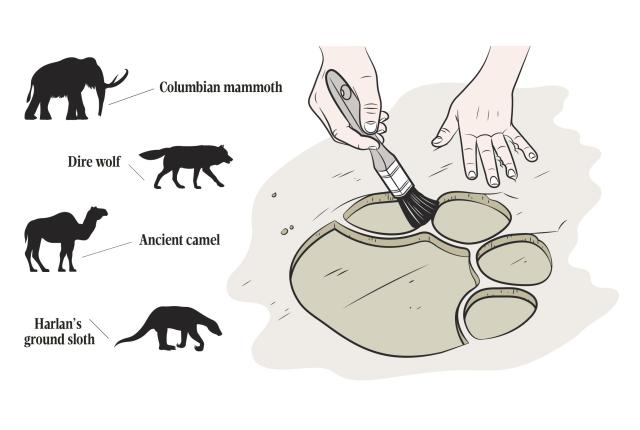Researchers have found footprints left by Ice Age animals and prehistoric humans. Illustration by Jameson Simpson.
ON THE FAR WESTERN FRINGE of the park, the dunes taper out to the edge of Lake Lucero. Here, in an area closed to the public, someone’s ancient footprints, laid in the mud of an Ice Age lake, track alongside those of mammoths and giant sloths, which lived in the area when this was a more verdant landscape.
The footprints show that an individual walked a long distance with a child on his or her hip, then returned alone. Children played in the puddle left in a giant sloth footprint, and hunters surrounded a sloth and taunted it so that the animal turned, while the killing blow came from its blind side. A mammoth and baby mammoth walked together, the adult nudging the younger one along.
“The thing about footprints is that they tell a story, a very emotive story, very easily, so you can read what’s going on,” says Matthew Bennett, a professor of environmental and geographical sciences from Bournemouth University who travels from the United Kingdom to White Sands several times a year. “It’s like a blank piece of canvas that people have run and played on for many years.”
In dwellings and pottery, even sandal fragments, tools, and garment bits, what a person thought or felt or paid attention to remains a mystery. But a footprint shows when and where people leaned into one another, how a child tugged at an adult, or how someone rose up on their toes for a better view. Thus, prehistoric humans become a little less abstract and a little more like us.
“It feels like a whole new level to understanding how these people interact that you wouldn’t get if you were just looking at those as artifacts,” says David Bustos, White Sands resource program manager.
Read More: The Mysteries of the Sands
Most footprint sites around the world record just a few steps, but the tracks at White Sands record thousands and preserve some of the oldest evidence of humans in North America. Back then, this was one of the largest wetlands in the Southwest—and where there is water, people are sure to follow.
Bustos invited Bennett and other researchers for a firsthand look at what’s called the White Sands Trackway in 2017. Their work together, published in recent and upcoming articles, often focuses on one set of tracks at a time to unpack a single interaction for everything it has to tell about human behavior millennia ago.
Bustos guesses the footprints weren’t visible when people first explored the dunes and even drove through this part of the park. As the sand atop them has eroded, they’ve come into view, but as that erosion continues, eventually it will erase the footprints, too.


